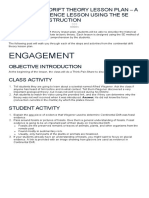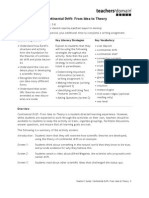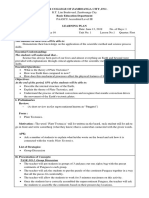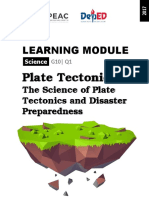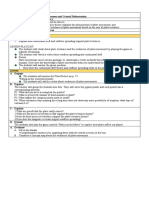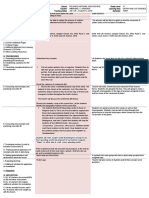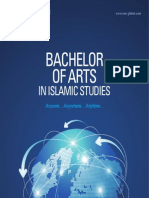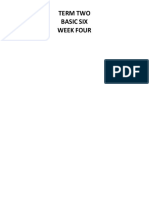0 ratings0% found this document useful (0 votes)
75 viewsLesson Plan Year 11 - Writing Task
Lesson Plan Year 11 - Writing Task
Uploaded by
api-414376990This lesson plan introduces students to the theory of continental drift through a video explaining Alfred Wegener's evidence and ideas. Students take notes on the video and answer questions about continental drift and the development of plate tectonics. They then analyze and rank the seven pieces of evidence for continental drift in groups. Finally, students write a persuasive letter supporting Wegener's theory of continental drift using the evidence and their notes. The lesson concludes by setting homework and allowing time for additional lithosphere activities if possible.
Copyright:
© All Rights Reserved
Available Formats
Download as DOCX, PDF, TXT or read online from Scribd
Lesson Plan Year 11 - Writing Task
Lesson Plan Year 11 - Writing Task
Uploaded by
api-4143769900 ratings0% found this document useful (0 votes)
75 views1 pageThis lesson plan introduces students to the theory of continental drift through a video explaining Alfred Wegener's evidence and ideas. Students take notes on the video and answer questions about continental drift and the development of plate tectonics. They then analyze and rank the seven pieces of evidence for continental drift in groups. Finally, students write a persuasive letter supporting Wegener's theory of continental drift using the evidence and their notes. The lesson concludes by setting homework and allowing time for additional lithosphere activities if possible.
Original Title
lesson plan year 11- writing task
Copyright
© © All Rights Reserved
Available Formats
DOCX, PDF, TXT or read online from Scribd
Share this document
Did you find this document useful?
Is this content inappropriate?
This lesson plan introduces students to the theory of continental drift through a video explaining Alfred Wegener's evidence and ideas. Students take notes on the video and answer questions about continental drift and the development of plate tectonics. They then analyze and rank the seven pieces of evidence for continental drift in groups. Finally, students write a persuasive letter supporting Wegener's theory of continental drift using the evidence and their notes. The lesson concludes by setting homework and allowing time for additional lithosphere activities if possible.
Copyright:
© All Rights Reserved
Available Formats
Download as DOCX, PDF, TXT or read online from Scribd
Download as docx, pdf, or txt
0 ratings0% found this document useful (0 votes)
75 views1 pageLesson Plan Year 11 - Writing Task
Lesson Plan Year 11 - Writing Task
Uploaded by
api-414376990This lesson plan introduces students to the theory of continental drift through a video explaining Alfred Wegener's evidence and ideas. Students take notes on the video and answer questions about continental drift and the development of plate tectonics. They then analyze and rank the seven pieces of evidence for continental drift in groups. Finally, students write a persuasive letter supporting Wegener's theory of continental drift using the evidence and their notes. The lesson concludes by setting homework and allowing time for additional lithosphere activities if possible.
Copyright:
© All Rights Reserved
Available Formats
Download as DOCX, PDF, TXT or read online from Scribd
Download as docx, pdf, or txt
You are on page 1of 1
Lesson Plan: Lesson 3
Unit/Topic: The lithosphere- Theory of continental drift Date: 30/ 05/2018
Key Learning Area: Geography Year Level: 11
LESSON STRUCTURE:
Time Introduction (Set): Teaching Approaches
75 min Re-cap activity/ Check homework: Plate tectonics worksheets (literacy Scaffold learning, on board, on
activity) screen (PowerPoint) etc.
Continue PP: Continental drift Individual/ Group
Students watch the following video on Alfred Wegener’s theory
of continental drift: Class discussion
http://www.youtube.com/watch?v=_5q8hzF9VVE
In workbooks, students take notes/ main ideas discussed Visual/ written stimulus
throughout the video- Focus on students taking notes based off
the evidence discussed in video. Writing scaffold
Students answer the following questions in workbooks (textbook
available for students to refer to)
1. Explain the theory of continental drift
2. What were the essential points in formulating the theory of plate
tectonics?
Group work: (In table groups)
Read/ analyse/ examine ALL SEVEN sets of evidence that have
been given on the theory of continental drift
In groups, you are required to rank the pieces of evidence from
most to least persuasive- That is, to decide what evidence best
supports Alfred Wegner’s theory (ranked 1) to the least
supportive evidence (ranked 7).
Individually: Persuasive writing task
Using the evidence provided, notes from book and the notes from the
video, students will:
Write a letter to the NSW public which supports Wegener’s
claims/ ideas on the theory of continental drift.
Students provided with instructions, scaffold for writing and writing
structure on board.
*If time allows: PP- How continents grow
Students answer the following questions in workbooks:
1. In what direction is the plate Australia moving and how quickly?
2. Explain the differences between diverging and converging plate
boundaries
3. Which mountain range is formed by the collision of the Indian
and Eurasian plates?
4. Describe how horizontal movement of plates cause mountain
building, earthquakes and volcanic activity
Conclusion of lesson (last 5 min)-
Set homework/ collect writing task.
If time allows/ Extra activities for students:
Students can begin to fill in Lithosphere Glossary definitions
(worksheet) using the textbook.
You might also like
- 6th Grade Plate Tectonics Lesson PlanDocument4 pages6th Grade Plate Tectonics Lesson Planapi-478684695No ratings yet
- Layers of The Earth Lesson PlanDocument3 pagesLayers of The Earth Lesson Planapi-352260293No ratings yet
- Science 10 7es Lesson Plan Quarter 1 Week 3 Day 5Document3 pagesScience 10 7es Lesson Plan Quarter 1 Week 3 Day 5Ericha Solomon100% (9)
- Geo - Stage 6 Lesson PlanDocument69 pagesGeo - Stage 6 Lesson Planapi-414376990No ratings yet
- NCM 107-109 OB Ward Clinical Instructional PlanDocument6 pagesNCM 107-109 OB Ward Clinical Instructional PlanJuriel Michael Alap100% (3)
- CONTINENTAL DRIFT THEORY LESSON PLAN - With 5EDocument9 pagesCONTINENTAL DRIFT THEORY LESSON PLAN - With 5EPEA PANLILIO100% (1)
- Life Sciences Week4 2of 4 PangeaDocument6 pagesLife Sciences Week4 2of 4 PangeamngomezuluNo ratings yet
- Teacher's Guide: Continental Drift: From Idea To Theory: Science Objectives Key Literacy Strategies Key VocabularyDocument4 pagesTeacher's Guide: Continental Drift: From Idea To Theory: Science Objectives Key Literacy Strategies Key VocabularyAbílio PintoNo ratings yet
- Creation of Atmosphere - Lesson Plan 2Document5 pagesCreation of Atmosphere - Lesson Plan 2hannahtubbs001No ratings yet
- Reset 6th Grade Lesson Plans - Layers of The Earth 12 8 2023Document14 pagesReset 6th Grade Lesson Plans - Layers of The Earth 12 8 2023api-735929865No ratings yet
- Earthquake Lesson Plan 1Document3 pagesEarthquake Lesson Plan 1api-155130180No ratings yet
- Grade Level Quarter / Domain Week & Day No. Page No.: Detailed Lesson PlanDocument7 pagesGrade Level Quarter / Domain Week & Day No. Page No.: Detailed Lesson Planargie joy marieNo ratings yet
- DLP 24Document2 pagesDLP 24Vanda RemaNo ratings yet
- S11ES IIe 34Document3 pagesS11ES IIe 34allanrnmanaloto0% (1)
- Lesson 2.15 and 2.16 Sea Floor Spreading and Ocean BasinsDocument2 pagesLesson 2.15 and 2.16 Sea Floor Spreading and Ocean BasinsJayson Cordero PorrasNo ratings yet
- Learning Plan Grade 10Document6 pagesLearning Plan Grade 10Mac-NielNo ratings yet
- Wrapping Tectonics Into One: Lesson PlanDocument7 pagesWrapping Tectonics Into One: Lesson Planapi-458629963No ratings yet
- 7Es-Lesson-waves COT1Document8 pages7Es-Lesson-waves COT1Noe Sialonga GayosoNo ratings yet
- 1st Quarter Lesson 1 Plate TectonicsDocument3 pages1st Quarter Lesson 1 Plate TectonicsJayjay SantosNo ratings yet
- 2017 Scig10q1Document64 pages2017 Scig10q1jimmyNo ratings yet
- Hot Vs Cold Lab Lesson PlanDocument4 pagesHot Vs Cold Lab Lesson Planapi-497020000No ratings yet
- Science Erosion Danielson LPDocument6 pagesScience Erosion Danielson LPMelissa MielkoNo ratings yet
- Activity 1 An Opinionative Essay On Climate Change - A Truth or Just An InconvenienceDocument7 pagesActivity 1 An Opinionative Essay On Climate Change - A Truth or Just An InconveniencemurpicantikbangetNo ratings yet
- DLLPDocument4 pagesDLLPCherry Degamo-AyagNo ratings yet
- Stemactivity-Pangaeaandbeyond1 2Document4 pagesStemactivity-Pangaeaandbeyond1 2api-321649012No ratings yet
- DLPJAZDocument5 pagesDLPJAZjazelle mae ypilNo ratings yet
- BIgbang LPDocument4 pagesBIgbang LPAileen gay PayunanNo ratings yet
- ADM Grade 11 Quarter 1 S1112ES Id 21 EditedDocument27 pagesADM Grade 11 Quarter 1 S1112ES Id 21 EditedLebz RicaramNo ratings yet
- Unit 1: Earth and Space CHAPTER 2: Earth's Internal Processes and Crustal Deformation Learning Competencies (Objectives:)Document1 pageUnit 1: Earth and Space CHAPTER 2: Earth's Internal Processes and Crustal Deformation Learning Competencies (Objectives:)Claudette Nicole GardoceNo ratings yet
- Science Lesson Plan 2Document6 pagesScience Lesson Plan 2api-511184697No ratings yet
- Science Lesson Plan Ball BearingDocument3 pagesScience Lesson Plan Ball Bearingapi-317545812100% (1)
- INT OceansDocument10 pagesINT OceanscomradeharleyNo ratings yet
- Land Breeze Sea Breeze AngeDocument2 pagesLand Breeze Sea Breeze AngeANGELIKA ABORITANo ratings yet
- Hawaiianisland LessonplanDocument4 pagesHawaiianisland Lessonplanjdanf001No ratings yet
- Els Week 8Document2 pagesEls Week 8alvinPaboresNo ratings yet
- Anisa Saigo Lesson Plan Earth ScienceDocument5 pagesAnisa Saigo Lesson Plan Earth ScienceAnisa SaigoNo ratings yet
- 5E Lesson Template: Classroom InteractionsDocument6 pages5E Lesson Template: Classroom InteractionsCristen Salandron CabayaNo ratings yet
- DLL - Science 10 - Quarter 1 - Week 6Document7 pagesDLL - Science 10 - Quarter 1 - Week 6marianne viodor100% (1)
- Lesson Guide in Earth and Life Science I. Objectives: The Process of EvolutionDocument4 pagesLesson Guide in Earth and Life Science I. Objectives: The Process of EvolutionJT SaguinNo ratings yet
- Iwb Lesson PlanDocument3 pagesIwb Lesson Planapi-249273995No ratings yet
- Nobel LessonDocument5 pagesNobel Lessonapi-224234568No ratings yet
- Platemovement Lesson4Document4 pagesPlatemovement Lesson4jdanf001No ratings yet
- Observation #1 - Science Writing LessonDocument7 pagesObservation #1 - Science Writing LessonAlexandra KeresztesNo ratings yet
- ww1 Unit PlanDocument7 pagesww1 Unit Planapi-473979420No ratings yet
- Geology 112 - Earthquakes Name - Activity 1 Worksheet - Introduction To The Course. What Is A Fault? What Is An Earthquake?Document137 pagesGeology 112 - Earthquakes Name - Activity 1 Worksheet - Introduction To The Course. What Is A Fault? What Is An Earthquake?Alvie GaydaNo ratings yet
- Lesson PlanDocument2 pagesLesson Planapi-361533000No ratings yet
- The Theory of Plate TectonicsDocument37 pagesThe Theory of Plate TectonicsblackpearlmelyNo ratings yet
- Q1 Week 5Document10 pagesQ1 Week 5CHERAMAE MORALESNo ratings yet
- Lesson 3 Adapted 2Document2 pagesLesson 3 Adapted 2api-318070288No ratings yet
- Based On Annex 2B.6 To Deped Order No. 42, S. 2016 Daily Lesson Plan Senior High School Balanacan National High School Melody M. MendozaDocument3 pagesBased On Annex 2B.6 To Deped Order No. 42, S. 2016 Daily Lesson Plan Senior High School Balanacan National High School Melody M. MendozaMelodyNo ratings yet
- Lesson Guide in Earth and Life Science I. ObjectivesDocument3 pagesLesson Guide in Earth and Life Science I. ObjectivesallanrnmanalotoNo ratings yet
- Detailed Lesson Plan June 24, 2019: Learning Areas Level Quarter DurationDocument2 pagesDetailed Lesson Plan June 24, 2019: Learning Areas Level Quarter DurationJuliville Hora SalinasNo ratings yet
- UNLV/Department of Teaching & Learning Elementary Lesson Plan TemplateDocument10 pagesUNLV/Department of Teaching & Learning Elementary Lesson Plan Templateapi-389623929No ratings yet
- Selana Moore 5e Lesson Final 1Document7 pagesSelana Moore 5e Lesson Final 1api-606450847No ratings yet
- Year 6 Earthquake Explorers FPDDocument6 pagesYear 6 Earthquake Explorers FPDapi-496564981No ratings yet
- July 5Document2 pagesJuly 5Immanuel GranadaNo ratings yet
- TG Science 11Document13 pagesTG Science 11Barcs UbarcoNo ratings yet
- Template For Assignment 1: Tiered LessonDocument13 pagesTemplate For Assignment 1: Tiered Lessonapi-428483615No ratings yet
- Contentpage 33 120 84 PDFDocument10 pagesContentpage 33 120 84 PDFPragati Kale100% (1)
- Deashni Lesson 1 EdstDocument5 pagesDeashni Lesson 1 Edstapi-280934506No ratings yet
- Grade 10 Science Lesson PlanDocument138 pagesGrade 10 Science Lesson PlanCharm Vergara100% (4)
- Accessible Elements: Teaching Science Online and at a DistanceFrom EverandAccessible Elements: Teaching Science Online and at a DistanceNo ratings yet
- Implications For Jessica's TeachersDocument5 pagesImplications For Jessica's Teachersapi-414376990No ratings yet
- Byron - English Assignment 1 FinalDocument19 pagesByron - English Assignment 1 Finalapi-414376990100% (1)
- Indigenous Essay - 17235482Document11 pagesIndigenous Essay - 17235482api-414376990No ratings yet
- Geo Assignment 1 - Final Copy - Nicolette ByronDocument51 pagesGeo Assignment 1 - Final Copy - Nicolette Byronapi-414376990No ratings yet
- English Assessment 1 - Aos - Nikki - FinalDocument11 pagesEnglish Assessment 1 - Aos - Nikki - Finalapi-414376990No ratings yet
- Lesson Plan - Aboriginal Pedagogies - Nicolette Byron - 17235482Document15 pagesLesson Plan - Aboriginal Pedagogies - Nicolette Byron - 17235482api-414376990No ratings yet
- Lesson Plan 6 Year 10Document1 pageLesson Plan 6 Year 10api-414376990No ratings yet
- Year 8 Lesson Plan - Water in The World - Water ResourcesDocument2 pagesYear 8 Lesson Plan - Water in The World - Water Resourcesapi-414376990100% (1)
- Persausive Writing Task Scaffold - Year 11 GeoDocument2 pagesPersausive Writing Task Scaffold - Year 11 Geoapi-414376990No ratings yet
- Geography of Human Wellbeing PP Nikki - FinalDocument73 pagesGeography of Human Wellbeing PP Nikki - Finalapi-414376990100% (2)
- Year 10 Geography Exam Feedback 1Document27 pagesYear 10 Geography Exam Feedback 1api-414376990No ratings yet
- Year 11 GeographyDocument1 pageYear 11 Geographyapi-414376990No ratings yet
- Part BDocument5 pagesPart BjeckNo ratings yet
- SCHOOL IMPROVEMENT PLAN WordDocument59 pagesSCHOOL IMPROVEMENT PLAN WordANGELENE BAUZON100% (3)
- Debate Script (UTS)Document5 pagesDebate Script (UTS)Nina FrancineNo ratings yet
- Test Bank For American Corrections 12th Edition Todd R Clear Michael D Reisig George F ColeDocument26 pagesTest Bank For American Corrections 12th Edition Todd R Clear Michael D Reisig George F Colecaradocbridget61rdNo ratings yet
- BAIS Booklet (Print)Document20 pagesBAIS Booklet (Print)Sana MoinNo ratings yet
- Running Head: A TEACHER'S PHILOSOPHY 1Document3 pagesRunning Head: A TEACHER'S PHILOSOPHY 1api-581772318No ratings yet
- Term 2 Basic 6 Week 4 12Document194 pagesTerm 2 Basic 6 Week 4 12Nharnah AbenaNo ratings yet
- Biomedical Admissions Test: How Hard Can It Be?Document23 pagesBiomedical Admissions Test: How Hard Can It Be?Chui WaiNo ratings yet
- Chirag Mahaveer Chivate SEMINARREPORTDocument20 pagesChirag Mahaveer Chivate SEMINARREPORTChirag McNo ratings yet
- Gandhi FellowshipDocument4 pagesGandhi Fellowshiptwinkle toesNo ratings yet
- English Language: With Teacher HannaDocument17 pagesEnglish Language: With Teacher HannaJo Hanna FaminianoNo ratings yet
- IPEd Activity Report Phase 2Document6 pagesIPEd Activity Report Phase 2Ling Pau100% (1)
- 3.-Ngoyahon-latest-Vesion0924 Trends Challenges and National Strategy For Student Mobility PhilippinesDocument21 pages3.-Ngoyahon-latest-Vesion0924 Trends Challenges and National Strategy For Student Mobility PhilippinesJoemari RiosNo ratings yet
- Kwanzaa Lesson Plan Edu 280Document2 pagesKwanzaa Lesson Plan Edu 280api-481114098No ratings yet
- Research Essay DraftDocument4 pagesResearch Essay DraftFierryl MenisNo ratings yet
- 21 June GR 10 LO Project FinalDocument15 pages21 June GR 10 LO Project Finalmbikophumelela13No ratings yet
- Types of Intelligence Tests GlossaryDocument2 pagesTypes of Intelligence Tests Glossarysmalakar05No ratings yet
- UNIT 4 Step UpDocument8 pagesUNIT 4 Step UpzaheiraNo ratings yet
- Cmap Science 7Document2 pagesCmap Science 7Zharina Ann EstavilloNo ratings yet
- Activity Completion Report: Literacy Instruction in EnglishDocument4 pagesActivity Completion Report: Literacy Instruction in EnglishBeverly Jane Glino AzuraNo ratings yet
- Edu216 ReviewerDocument19 pagesEdu216 Revieweraque.angelgrace08No ratings yet
- Subjective Type TestDocument51 pagesSubjective Type TestMhimi ViduyaNo ratings yet
- A Qualitative Study On A Situated Experience of Technology Integration: Reflections From Pre-Service Teachers and StudentsDocument28 pagesA Qualitative Study On A Situated Experience of Technology Integration: Reflections From Pre-Service Teachers and StudentsSri HandayaniNo ratings yet
- Portfolio RecordDocument3 pagesPortfolio RecordwakiroivanNo ratings yet
- Relationship Between Learning StrategiesDocument12 pagesRelationship Between Learning StrategiesJunalie GregoreNo ratings yet
- A New Language of School DesignDocument237 pagesA New Language of School DesignRachNo ratings yet
- B1 Preliminary Writing Part 2 StoryDocument7 pagesB1 Preliminary Writing Part 2 StoryYolandaNo ratings yet
- Math Mini ResearchDocument5 pagesMath Mini ResearchEllah Marie FlorentinoNo ratings yet





